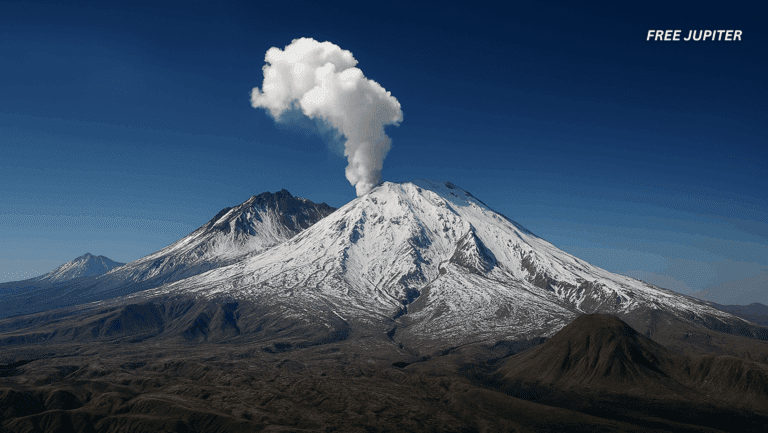Friendly Note: FreeJupiter.com shares general info for curious minds 🌟 Please fact-check all claims—and always check health matters with a professional 💙
For decades, Uranus has quietly sat on the sidelines of scientific attention—spinning sideways, glowing faintly, and minding its own business near the icy outskirts of our solar system. Often overshadowed by its flashier neighbors like Jupiter’s massive storms or Saturn’s dazzling rings, Uranus has long been seen as the quiet oddball of the giant planets. Not because of its looks, but because of something even stranger: it just didn’t seem to give off much heat.
While its fellow gas and ice giants shine with internal energy that far exceeds the warmth they get from the Sun, Uranus looked like it was barely generating any extra heat at all. For planetary scientists, this was the equivalent of finding a campfire that doesn’t burn. Why would one planet be so different?
This cold enigma has puzzled researchers ever since NASA’s Voyager 2 spacecraft gave Uranus a fleeting flyby in the 1980s. The spacecraft recorded bizarre data that painted Uranus as unusually inactive, especially when it came to heat. And for nearly four decades, that image stuck.
But science, like space, is full of surprises.
Now, thanks to a fresh dive into old data and new modeling techniques, researchers are warming up to a different picture of Uranus—one where it might be radiating more energy than we once believed. This surprising twist doesn’t just change how we see this overlooked planet; it may reshape how we understand all the giants of our solar system, and even the formation of planets beyond.
Wait—So Uranus Isn’t a Cold Oddball?
A new study published in Geophysical Research Letters reveals something surprising: Uranus does release more heat than it absorbs from the Sun—about 12.5% more, to be exact. That may not sound like much, especially when you compare it to Jupiter and Saturn, which each emit more than double the solar energy they receive. But for a planet once considered to be nearly “heat-dead,” this discovery is a big deal.
In simpler terms: Uranus is no longer the outlier it once appeared to be. It still has its quirks, but it’s not totally breaking the cosmic mold anymore.
Read more: Stephen Hawking’s Final Research Paper May Have Predicted The End Of The Universe
The Long Game: Studying Uranus Over 84 Years
To arrive at this finding, scientists looked at data spanning decades—because one year on Uranus lasts 84 Earth years. That’s how long it takes the planet to complete a single orbit around the Sun. During that time, Uranus experiences dramatic shifts in sunlight due to its extreme axial tilt of 98 degrees—it basically rotates lying down on its side.
This unusual orientation causes massive seasonal changes. For about 20 years at a time, one pole points directly at the Sun while the other is plunged into total darkness. Then the roles reverse. These long, lopsided seasons could influence how the planet stores, circulates, and releases internal heat.
The team behind the study combined decades of Earth-based and spacecraft data with climate models to map Uranus’s energy budget across its full orbit. They noticed fluctuations tied to its seasons, hinting that the planet might store heat during certain phases and let it escape during others.
Still Cooler Than the Cool Kids—but Why?
Even with this newly confirmed internal heat, Uranus still emits far less energy than its planetary peers. Neptune, for instance, radiates about 2.6 times more energy than it absorbs, despite being nearly the same size and composition as Uranus. So what gives?
Scientists aren’t entirely sure yet, but they have a few ideas:
- An Ancient Impact: One leading theory is that Uranus suffered a colossal collision with a large object early in its history. This could’ve knocked it sideways and disrupted the usual flow of heat from the planet’s core to its atmosphere.
- A Layered Interior: Another idea is that Uranus has internal layers that act like insulation, trapping heat deep inside instead of letting it rise to the surface.
- Different Formation Path: Uranus may have formed differently than the other gas giants, ending up with a less active interior.
These are just hypotheses, though. More direct measurements—and a closer look at Uranus’s atmosphere and core—are needed to know for sure.
Read more: Astronomers Detect The Most Powerful Explosions in the Universe Since the Big Bang
A Planet of Long Seasons and Strange Weather
Uranus’s seasons, which stretch for two decades at a time, are unlike anything we experience on Earth. These seasons aren’t just about sunlight; they likely affect wind speeds, storm systems, and possibly even how the planet’s core behaves.
For instance, during Voyager 2’s visit, Uranus appeared mostly calm and featureless. But in recent years, powerful storms have been spotted in its atmosphere using telescopes like Hubble and Keck. It turns out Uranus might be more active than it let on during its brief encounter with Voyager.
Understanding these seasonal swings is more than just a curiosity. It helps scientists fine-tune models of how planetary atmospheres work—not only in our solar system but in distant planetary systems as well.
Why This Discovery Matters for Earth (Yes, Really)
At first glance, what Uranus does billions of kilometers away might not seem relevant to life here on Earth. But studying distant planets isn’t just a nerdy space hobby—it’s a critical part of understanding our own world.
According to co-author Liming Li from the University of Houston, by learning how Uranus stores and releases heat, we can get better insights into atmospheric circulation, weather systems, and climate dynamics. These principles apply to Earth, too—especially as we confront complex challenges like climate change.
In other words, the lessons from a weird, sideways, distant planet could one day help us understand how energy and heat move around our own atmosphere.
What’s Next? A Much-Needed Mission to Uranus
Despite being one of the largest and most intriguing planets in our solar system, Uranus has only had one flyby visit—from Voyager 2 nearly 40 years ago. That’s like glancing through a peephole and trying to understand a mansion.
Scientists are now pushing for a full-fledged NASA mission to Uranus, complete with an orbiter and possibly even a probe to dive into its atmosphere. Such a mission could answer lingering questions about its heat output, magnetic field, weather patterns, and internal structure.
The planet’s complex seasons, possible ancient trauma, and still-mysterious heat flow make it an irresistible scientific target.
In Conclusion: Uranus Is Heating Up—In More Ways Than One
Far from being the frozen misfit of the solar system, Uranus is turning out to be a lot more dynamic than we gave it credit for. It may not shine as brightly as Jupiter or Saturn in terms of heat, but it’s warming up to the idea of being a proper giant—just with its own twist.
As we continue to study Uranus, we’re not only unlocking the secrets of a strange and beautiful world—we’re also gaining a broader understanding of how planets live, evolve, and interact with their environments. Whether it’s about cosmic collisions or subtle heat drifts, Uranus is teaching us that even the coldest places in space can still surprise us.










